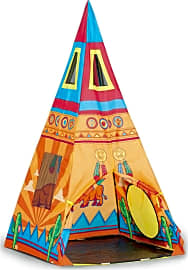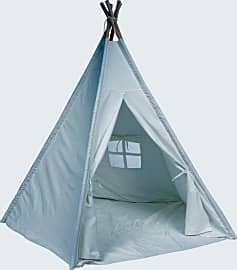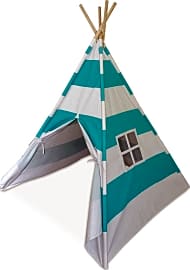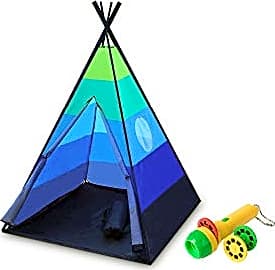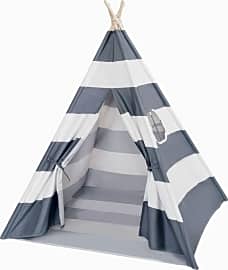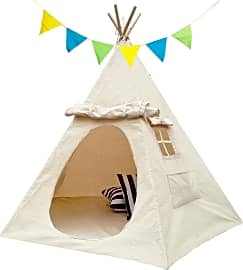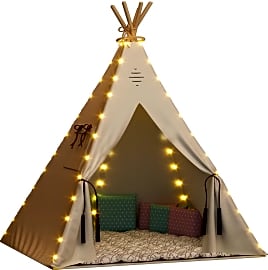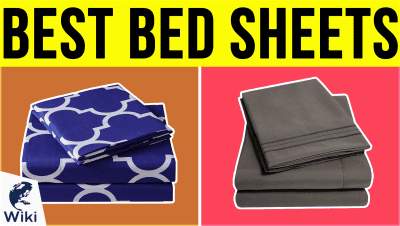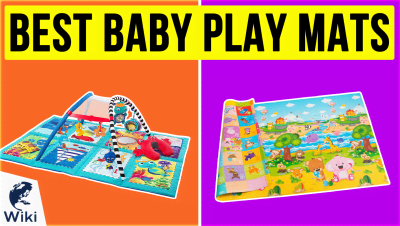The 10 Best Kids Teepees

This wiki has been updated 42 times since it was first published in January of 2016. If you’re tired of having to reclaim pillows and sheets in your home because the kids have used them to make a tent, a simple solution is to get one of these teepees. They’ll provide youngsters with their own personal spot for reading, playing, or simply getting away from boring adults. They come in both breathable cotton and durable polyester fabrics, and fold up easily for storage and transport. When users buy our independently chosen editorial recommendations, we may earn commissions to help fund the Wiki.
Editor's Notes
February 11, 2020:
Teepees are an affordable and fun addition to any young child’s bedroom or play room, and they come in plenty of attractive designs as well as plain ones that are easy to customize. They’re great for parents who find themselves routinely picking up pillows and bedsheets after the kids have been creating makeshift forts.
New to our list today is the TazzToys Set, which is an all-inclusive model that comes not only with a teepee, but also strands of battery-powered fairy lights, decorative, glittery feathers, a drawstring carrying bag, and a colorful flag banner. This makes it a great gift in that you don’t have to shop around for additional lights and other embellishments. It’s also equipped with a waterproof base that makes it suitable for use outdoors. Unlike most others, it has two pockets for storage and two windows for ample airflow. The curtains and front flap are completely closable, so your little one can have plenty of private time reading or playing. Like some others on our list, such as the Trademark Innovations Play House and the Little Dove Foldable, this one comes in a neutral, plain color that makes it easily customizable with acrylic paints or those that are water- or oil-based. This selection replaces the Pericross Play on our list, which is rather difficult to assemble, and its connectors are not the most durable.
The Pacific Play Santé Fe stays in a top spot on our list, and it features fun, brightly colored graphics, for hours of fun. It’s got windows toward the top of each panel to let in plenty of light, and its waterproof floor makes it suitable for use outside. This one has two doors that make it convenient for your little monkeys to jump into and out of it, and the sturdy base ensures it won’t tip over easily.
As a rule, be sure to create a safe playtime by always supervising children closely when they are spending time in and around these fabric and wooden structures.
Special Honors
Isabelle & Max Halton Baby Pop-Up This teepee is sure to bring loads of fun to your toddler, and it looks stylish and elegant in any nursery. It’s handcrafted with a base that is 100% cotton, and four rows of 3-inch ivory lace around the door with ivory satin ribbon tiebacks. It’s suitable for children who are crawling all the way up to the age of four. Designed for indoor use, it comes with the required poles and conveniently collapses like an umbrella. It features a 45-inch height and a 30-inch width, and weighs two pounds. wayfair.com
Adventure Blue Playhouse With its blue and white design, this simple, yet bold, tent can match almost any home décor. It’s made to hold up for years of play, with fabric that's durable cotton canvas and poles that are metal. It can be personalized with a child's name, which makes it feel more special and unique. crateandbarrel.com
The Ultimate Play Space: The Children's Teepee
This makes the teepee a great choice for the home where space is at a premium; even a city apartment dweller can keep one on hand.
Children often present their parents (or other caregivers) with frustrating paradoxes. A tired child will deny his or her fatigue, vehemently resisting sleep despite rest being the one thing his exhausted body need. Kids will reject a favorite food out of spite not realizing that the only person they are truly punishing is themselves. And while children love feeling a sense independence and freedom, in fact they innately crave boundaries and rules.
A caregiver who is aware of these contradictions can curtail many potential conflicts by working to arrange a child's life in a manner that respects the youngster's need to feel empowered while also creating the structure the child requires. One of the best ways to help your child feel safe and satisfied is to create a play space in which he or she feels entirely at ease and in control. Whether you have an entire playroom to manage, you are setting up the child's bedroom to accommodate their need for personal play space, or you are trying to establish a corner of your home as a dedicated area for your child to enjoy independently, a children's teepee is a great idea.
A teepee provides a child a private place for reading books, spending time with friends (or with their stuffed animals or dolls), for playing games, or simply for spending quiet time alone napping, relaxing, or recovering after a tantrum. As most teepees feature flaps that close, they provide a genuine sense of personal space, yet of course the care provider still knows exactly where the child is and can surreptitiously check on the youngster by glancing through a window or down into the top of the teepee.
When choosing a teepee, consider both the appearance and the size of the diminutive dwelling. Some options have animal prints, while other varieties come in multiple colors and/or patterns; it should be easy enough to choose one with a look your child will love. In terms of physical size, some teepees measure around three feet on a side, taking up a total area of nine square feet, while others measure more than four feet on a side, which adds up to sixteen-plus square feet of floor space required and which may be too large for some homes. If you know the room in which you will likely set up the teepee, try to buy one that will not crowd the space.
Perhaps the aspect parents (or grandparents or other relatives or friends) will like the most about a teepee is how easily it can be folded up and put away. Most kid's teepees, once assembled initially, can be collapsed into a tall, slender package in a matter of seconds. A teepee thusly packed away can be tucked into a closet or slid under a bed, requiring only minimal free space for storage. This makes the teepee a great choice for the home where space is at a premium; even a city apartment dweller can keep one on hand. Also note that most teepees can be tucked into the back of an SUV or van for easy transport during playdates or for extended visits to friends and family, which helps bring familiarity to places away from the home.
Ideal Kids' Teepee Accessories
As noted, a kid's teepee can serve as everything from a play space to be shared with playmates to a phrontistery for reading and pondering to a quiet space for napping and/or calming down after a disagreement. But the basic teepee may benefit from the addition of some accessories and enhancements if it is going to be long enjoyed.
This will help keep the room less cluttered and add to the youngster's sense of independence.
First and foremost, consider getting a large pillow or mat that can be laid down inside the teepee, ensuring that it is a comfortable enough place for a youngster to sit, lounge, or flop down for a rest. Many brands actually sell pillows expressly designed to fit into their teepees, and in other cases a suitable pad or pillow is easy enough to find. A padded mat that is larger than the footprint of the teepee works well, so consider repurposing the play pad your child rolled about on as an infant for a mat he or she can enjoy again underneath the teepee.
Next, consider adding lighting to the teepee so that your child can read books or play games with the flaps closed and without the need for the main light sources in the room to be illuminated. Strands of battery-powered LED lights are the best choice for use in teepees, as they give off softly glowing light that won't hurt the eyes, and as they require no potentially unsafe connection to a wall outlet. Weave the lights securely into the upper posts of the teepee and leave the on/off switch in reach of your child.
Some teepees have pockets ideal for storing a few books or toys; if you have chosen an option without this feature, consider tucking a basket inside the teepee, thus giving the child a place to store a few favorite items. This will help keep the room less cluttered and add to the youngster's sense of independence.
A Brief History of the Teepee
The teepee -- which is alternately spelled tipi and tepee -- was for many centuries the chosen dwelling for the peoples indigenous to the plains and prairie lands of North America. They were rarely if ever used by natives living in other areas, contrary to common misrepresentations. These conical dwellings consisted of multiple tall, slender, and sturdy wooden poles over which were stretched animal hides -- usually sourced from buffalo -- and/or at times sheets of fabric.
After the introduction of horses, ever larger teepees were used, many of which could accommodate two dozen or more people during gatherings.
Teepees were ideal shelters for the semi-nomadic plains natives, as they could be set up and broken down with ease, and as the shelters were readily portable; this factor was of the utmost importance prior to the spread of horses across the Americas in the 16th century. After the introduction of horses, ever larger teepees were used, many of which could accommodate two dozen or more people during gatherings.
The teepee was readily modifiable, with flaps that opened near the top to allow smoke to drift up and out as needed and with large swaths of fabric that opened to create a doorway for access and ventilation, or sealed to preserve warmth. Also, contrary to misconception, most were left unadorned, though some teepees were simplistically painted to commemorate victorious battles, hunts, or for ceremonies.
By the turn of the last century, forced settlement on reservations and the general acceptance of more modern and permanent building materials and techniques had rendered the teepee a relic of the past, though they are still used today for ceremonial and commemorative purposes.


